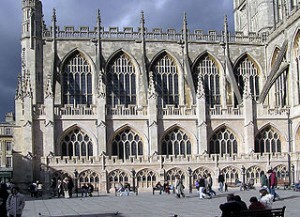Everyone's seen flying buttresses. They're those huge pillars on the sides of European cathedrals. Notre Dame (the one in France completed in 1345, not the one with the football team) is among the most famous.

The Flying Buttress
Though they look like they wouldn't be good for much other than making sure that a wall doesn't fall over (sometimes used that way) and making grade school kids laugh, they're the only reason that buildings of that size were even possible in those days.
Flying buttresses actually help support the weight of the ceiling. Before flying buttresses, the walls had to be immensely thick in order to prevent the ceiling's weight from pushing the walls outward.
Flying buttresses form a natural arch with the roof, thereby taking much of the outward force generated by the roof's weight off the walls. This allows the walls to be built much thinner. And it also allows the inclusion of the immense windows in the walls that cathedrals are so famous for.
The construction of the buttresses was a difficult enough task in itself, of course. It first involved the construction of temporary wooden frames, or centering to be hoisted up between the wall and the column. The centering was what kept the arch of stones in the air while the mortar was drying, serving as the arch in the meantime.
Frequently, early cathedrals with flying buttresses were built with much thicker, closer, and more immense buttresses; the backers funding the construction weren't entirely convinced that they would actually work. Some of the buttresses were actually so huge that they blocked out much of the light coming in.
Even cathedrals with much, much thinner buttresses have lasted until today. And a building that lasts for 800 years does tend to speak for itself pretty well.